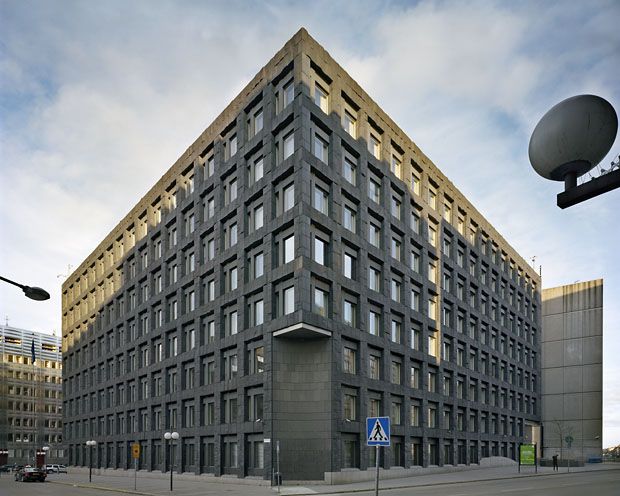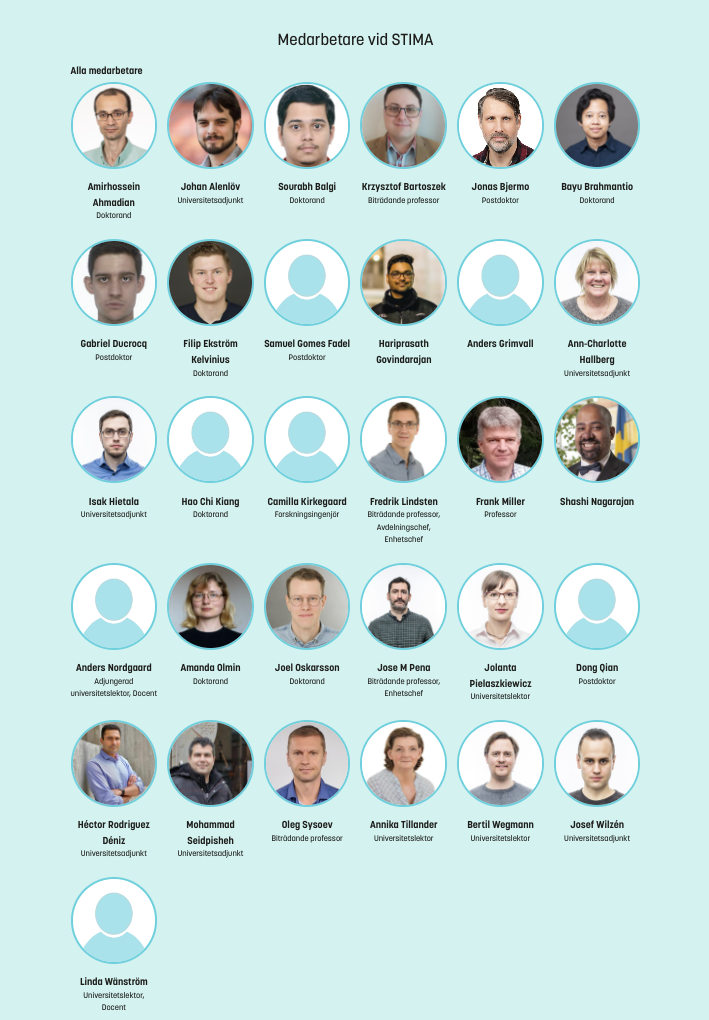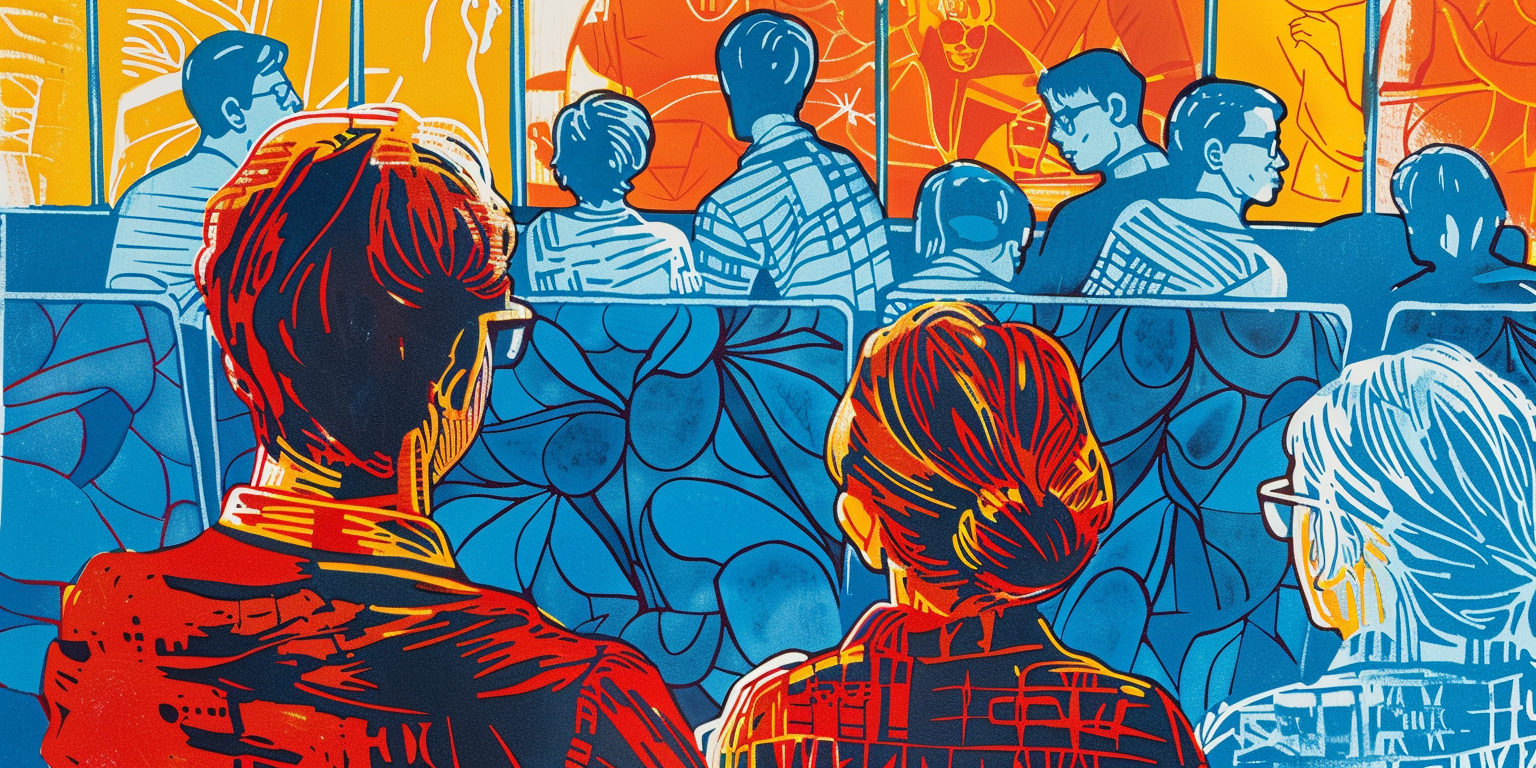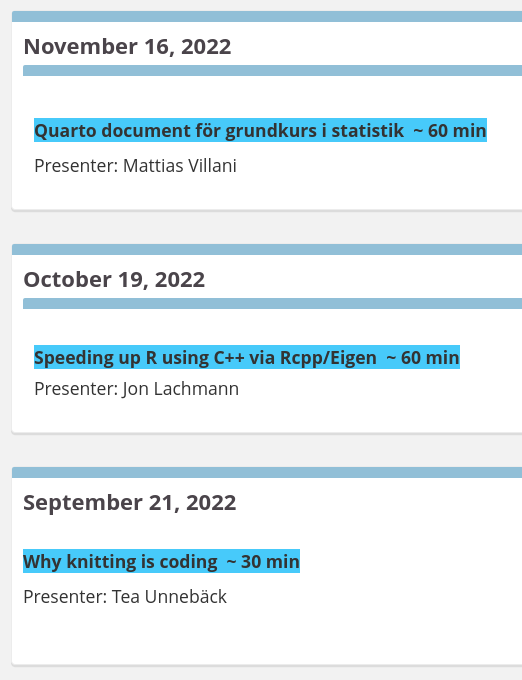Developing a research culture in teaching-dominated environments
Department of Statistics
Stockholm University
My experiences and influences
- Stockholm University:
- PhD in Statistics in 2000.
- VR forskarassistent 2001-2003.
- Senior lecturer (lektor) 2003-2011.
- Professor 2018-
- Researcher and Adviser, Central Bank of Sweden, 2003-2011.
- Professor and Head of Division of Statistics (and Machine Learning), Linköping University, 2011-2018.
- Senior visiting scholar, University of New South Wales, Australia.
My experiences and influences


The premise
Many academic departments have heavy teaching.
Teaching is intense and students depend on us.
Teaching have shorter time scales than research. Crowding out.
Teaching culture can quickly become dominant.

Research culture
How to develop a research culture and maintain teaching efforts?
OED: a way of life or social environment […]
Naturally occurring research discussions at the coffee machine.
Is it possible to develop a culture, or must it happen organically?
Synergistic relationship between teaching and research?

The simple solution
- Just increase research time for all lecturers …
- Increase external funding.
- Good research is a prerequisite for external funding.
- How to get the wheel moving in the right direction?
- What should we prioritize given a limited internal research budget?
- It must be a joint effort, to improve work satisfaction for everyone.

Increase external funding - some activities
- Overview seminar on funding by university administration.
- Seminar on funding agencies by dept researchers.
- each researcher presents a funding agency
- focus? calls? grant sizes? what projects are being funded?
- Seminar with successful grant applications.
- Curated list of calls and agencies on internal dept page.
- Reminders at dept meetings. Email alerts. Grant calendar.

External funding for junior researchers
Connect junior researcher to senior mentor for a grant proposal.
Grant-pitching seminars for feedback and a senior connection.
Feedback throughout the process, particularly on “the big picture”.
Plus/Minus: Mentor may end up as co-applicant.
Co-applicant in established research group, also in other subjects.
“Consulting” towards other departments to get contacts.

The physical environment matters
Suitable offices and equipment for thinking and creating.
Library and database access and all of that.
Key physical books in smaller department library.
Brainstorming rooms with big display, whiteboards, comfy chairs.
Whiteboards in the coffee room for spontaneous discussions.
New books (research monographs) on display in coffee room.
Bulletin board with
- recent conference posters by staff members
- posters of master’s theses and PhD student papers.
Research seminars
Why?
Learning about new research.
Learning about the subject, both broad and deep.
Research trends - important for less active researchers.
Meet other researchers.
Fund the seminars
Attract speakers from abroad.
Get speakers to stay for some days.
Schedule one-on-one meetings with speaker.
Also with PhD students and less research active staff.
Research seminars - make them important
Make seminars visible on a public web page, incl past seminars.
Link to past seminars when inviting speakers. Stars attract stars.
When paper is available, distribute it to staff for better discussion.
PhD course credit for acting as unofficial mini-discussant.
Distribute the invitation and hosting across all researchers.
Make it the department’s seminar series.
Get people here, send people away
- Mobility is undervalued (in Sweden).
- Hard because we typically need our teachers. Long term planning.
- Guest professors. Course and discussing research. Sabbaticals.
- Informal shorter exchange of staff between universities.
- PhD students on longer pre-doc visit to top research environment.
- Scholarships and travel support. URA-agreement is ideal, but costly.
- Easy and cheap guest housing on campus would do wonders.
Learning together - journal clubs etc
- Breaks (prestige) barriers and opens up for collaborations.
- Reading groups to discuss current or foundational articles:
- Small groups in research areas, perhaps online with other uni
- Larger group at dept level
- Read a book together, each person is responsible for a chapter.
- Micro-seminars
- Small research groups with PhD students, post doc and senior(s).
- Make junior researchers (involved) co-supervisors.
Tech talks at SU
- Informal meeting every fourth week at 4-5 pm.
- Short presentations (5-60 mins) from staff.
- Master’s students also welcome.
- Dinner afterwards. BYO, order in, or university restaurant.

Research-teaching synergies
- Education grounded in research benefits also lecturers.
- Students also build research culture. Let them in.
- Make basic courses research-inspiring. Teams incl professor.
- Make advanced courses research-preparing.
- ➡️ research-oriented master theses.
- Master thesis supervision activates a supervisor’s research nerve.
- Research project course with students partipating in research.
- Second year of master’s used to be first year of PhD.
- Invite (master) students to research seminars.
Publication outlets
- Publication record main determinant for funding and positions.
- Little time for research, important to place your research well.
- Finding the right journal can be hard, especially for juniors.
- Aim too high/wrong ➡️ reject ➡️ resubmit, but aim too low.
- Publication “emails”:
- share info about research
- share info about journals
- share info about (rejection/revision) path to publication.
- celebrate a colleague’s success. 🥳
- Journal rankings, but also experienced colleagues’ rankings.
- Your colleague’s success is good for dept and therefore also for you.
- ⚠️ Obsessive ranking mentality (Top 3) can be crippling.
Publication email - example
We recently got the paper ‘Real-Time Robotic Search using Hierarchical Spatial Point Processes’ accepted for publication in the machine learning conference ‘Uncertainty in Artificial Intelligence’ (UAI2019).
The paper is joint work with my PhD students Olov Andersson (Robotics) and Per Sidén (Statistics), my previous post doc Johan Dahlin (Automatic Control) and Prof Patrick Doherty (Robotics). It is funded by Patrick’s and my SSF project in Smart Systems.
Abstract: Aerial robots hold great potential for aiding Search and Rescue (SAR) efforts over large areas. Traditional approaches typically searches an area exhaustively, thereby ignoring that the density of victims varies based on predictable factors, such as the terrain, population density and the type of disaster. We present a probabilistic model to automate SAR planning, with explicit minimization of the expected time to discovery. The proposed model is a hierarchical spatial point process with three interacting spatial fields for i) the point patterns of persons in the area, ii) the probability of detecting persons and iii) the probability of injury. This structure allows inclusion of informative priors from e.g. geographic or cell phone traffic data, while falling back to latent Gaussian processes when priors are missing or inaccurate. To solve this problem in real-time, we propose a combination of fast approximate inference using Integrated Nested Laplace Approximation (INLA), and a novel Monte Carlo tree search tailored to the problem. Experiments using data simulated from real world GIS maps show that the framework outperforms traditional search strategies, and finds up to ten times more injured in the crucial first hours.
Computer Science has a completely different publication culture than Statistics, where the majority of publications are 6-10 pages papers in conference proceedings. The conferences are ranked and some of the conferences have higher status than the best journals. So, unlike Statistics, conference proceedings really matters. The top general conferences in machine learning are NeurIPS and ICML. Those conferences are ranked A+. UAI is ranked A, so it is a very good conference specialized in probabilistic modeling (mostly graphical models) for AI. The accept rate for UAI this year was 26% (compared to 20% for NeurIPS).
It is common in Robotics to complement the experiments in the paper with a video. Here is our video for the paper: https://www.youtube.com/watch?v=wyD0O5hF5tE.
Making research and researchers visible
- Clear web page with research profiles and groups.
- Department web page for each researcher.
- Google Scholar or similar profile page.
- Personal web page linked from department web.
- Make course material public.
- Social media and blogs can be great for networks and feedback.
Concluding remarks
- Developing a research culture is doable if it is a collective effort.
- Staff likely to support the idea (may disagree on method).
- Good research requires funding. Funding requires good research.
- It takes some effort to make the wheel spin in the right direction.
- Support and encouragement from management is crucial.
- Important to value researchers’ time. Use meeting time wisely.
- Communication and information sharing is important. Tools matter. Internal and external web.
- “Black box” money for grant writing, guests etc is really useful.
Thanks for listening!
I would love to hear your thoughts and ideas now!